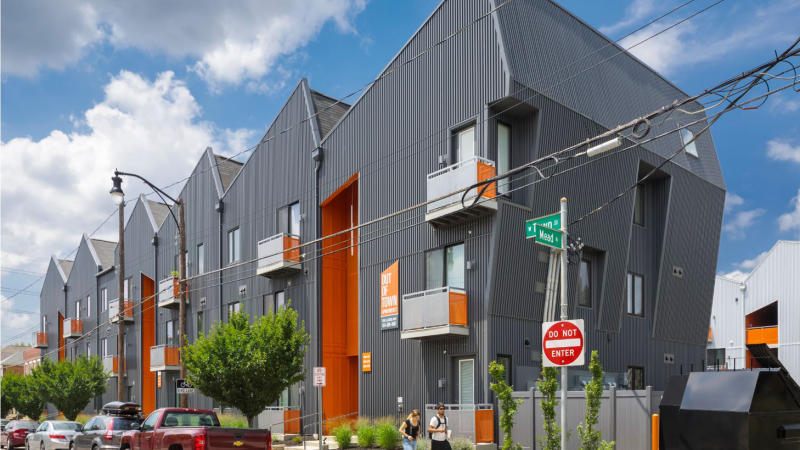OUT OF TOWN: Designing for the Residential Movement in Franklinton
Franklinton will be the site of a new housing development designed by Blostein/Overly Architects (BL/OV), a Columbus-based practice founded by Beth Blostein, RA, associate professor of architecture, and Bart Overly, RA, lecturer at the Knowlton School. Titled, "OUT OF TOWN," the project will include 36 one-bedroom apartment units and nine two-bedroom units. Scheduled to be built on a .8 acre site located on West Town Street in the second quarter of 2017, the project is being developed in a joint venture between Metropolitan Holdings and Arch City Development.
Due to its proximity to downtown and some of the newer parts of the east Franklinton Arts District, the two-building project is tailored to a young generation. The focus of continued development and revitalization, the neighborhood hosts The Columbus Idea Foundry, a maker space with open studios and classrooms, and 400 West Rich, an old manufacturing warehouse turned into a mixed-use complex with event space, artist/music studios, offices, and art galleries. With the influx of developers and businesses moving into the area, the residential component is beginning to slowly catch up to the more leisure-focused elements in the neighborhood. Brian Polgar (MArch '15), an associate at BL/OV, says, "One of the things that gets us excited about this project is its scale. Its construction will put it on the forefront of the residential movement that has been talked about for several years."
"Franklinton is shifting. This particular area is fighting between two identities: a new industrial arts district and an established residential neighborhood.” Overly continues, "We wanted to pick up on this shifting quality with the mass of the building." The choice of materials, in particular an exterior skin of corrugated metal, and a shifting sawtooth elevation that slowly transitions into a more residential gable roof at the other end, reference the industrial past of the area while also providing the design with a contemporary feel.
With a number of developed projects in Columbus, Overly doesn't feel his design company holds to a particular style. Rather, he says, his office is interested in formal responses to cultural influences. At OUT OF TOWN, a “lazy registration” layers multiple repetitious patterns to create random and unique qualities for a project that might otherwise be highly repetitious. Overly says, "We're looking at new ways of accepting repetition, while generating very distinct result with lots of variation.”
Another interest of BL/OV is the design and integration of fabricated pieces in a developed project, as Overly says: "We're always looking for opportunities when we can challenge the traditional notions of what an architect is to a project, and bring attention back to the craftsman." In this regard, Polgar's work at the practice has been valuable as Overly notes: "He's very thoughtful and skilled as a designer. He's also a talented fabricator."
While still a graduate student at the Knowlton School, Polgar began working with BL/OV on the “Coney Island Project,” an award-winning parking lot attendant booth designed to combine art and function, which was part of the Bold Booths project in downtown Columbus. Polgar worked on several pieces of design and fabrication for the project, specifically the interior built-in chair and desk. With a BFA in Sculpture, Polgar indicates that this focus on fabricated pieces speak not only to the design firm's commitment level to their projects, but also fulfills his "fabrication and maker tendencies."
Polgar's work with Blostein and Overly, who were his instructors during his tenure in the Knowlton School’s Master of Architecture program, continues on the "OUT OF TOWN" project. He is presently "focusing on the design development of the project, the specific details, the materials, as well as dealing with all the models and the drawing sets." During the fall semester, 2016, the newly graduated Polgar also taught a section of the sophomore architecture design studio. With his stint teaching and on-going work with his former instructors, he is "excited about being a part of the design culture" in Columbus as his future unfolds.


